Buy one component and save 10% on up to 2 cables. Buy 2 components and get 4 free cables. Free shipping on USA orders over $700.
Buy one component and save 10% on up to 2 cables. Buy 2 components and get 4 free cables. Free shipping on USA orders over $700.
Calculating the Performance of an Amplifier-Speaker Combination - Example 2
by John Siau October 27, 2017
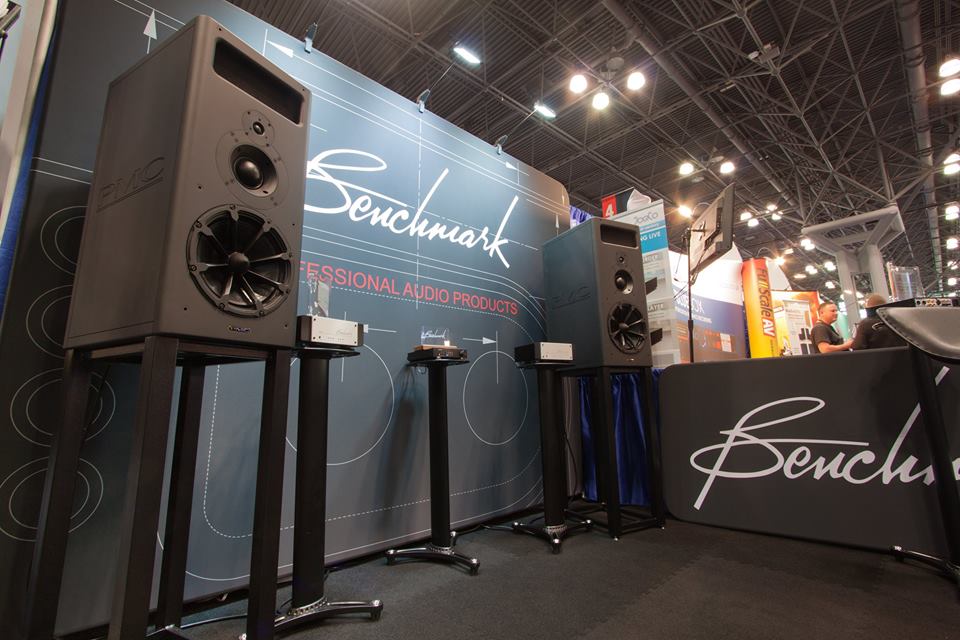
In this application note we calculate the maximum output level and noise level produced by an amplifier-loudspeaker combination. Use this example for calculating the performance of your system.
Example 2 - PMC MB2S
At the 2017 AES show we demonstrated two Benchmark AHB2 monoblock power amplifiers driving a pair of 4-Ohm PMC MB2S studio monitors.
We were extremely impressed by the unusually clean, distortion-free output of these monitors. They fully compliment the distortion-free performance of the AHB2 to provide a system that was cleaner than any monitoring system we had heard prior to this. We had the opportunity to compare these passive monitors to some very high-quality powered monitors and there was no comparison. The passive MB2S monitors driven by the AHB2 were much cleaner than the powered monitors. This underscores the importance of good amplification and good driver design. Both are essential in a precision monitoring system.
This application note can serve as an example for calculating maximum sound pressure levels (SPL) and noise output levels for an amplifier/speaker combination. We will run through the calculations for Benchmark AHB2 monoblock amplifiers driving 4-Ohm PMC MB2S monitors.
SPL Calculations:
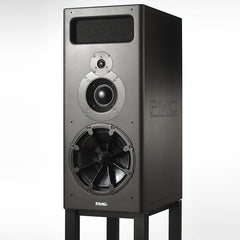
The PCM MB2S monitors have a power sensitivity of 91 dB, 1 W @ 1 m. At 4 ohms, this is equivalent to a voltage sensitivity of 94 dB, 2.83 V @ 1 m (add 3 dB for 4-ohm speakers when doing this conversion). From the voltage sensitivity, we can calculate the maximum sound pressure level when the monitors are driven from AHB2 amplifiers running in mono mode.
With a 4-Ohm load, the AHB2 monoblocks will deliver 518 Watts. The maximum unclipped output voltage is 45.5 Vrms (64.4 V peak) into a 4-Ohm load. This is 24.1 dB higher than the 2.83 Vrms level where voltage sensitivity is normally measured (20*log(45.5/2.83)=24.1 dB). If we add 24.1 dB to the voltage sensitivity of 94 dB we can calculate that the maximum sound pressure level should be about 118 dB at 1 meter from each monitor. This calculation ignores the slight losses that would be produced by power compression due to voice coil heating. Given the size of the voice coils in the MB2S drivers, power compression should be minimal in this example.
Given the 118 dB maximum SPL, this amplifier/monitor combination will have no trouble filling a good sized control room. Note that these monitors are 2 dB louder than the IB2S monitors we demonstrated at the 2016 AES show in Los Angeles. The 118 dB peak SPL capability of this system indicates that it will provide plenty of headroom when delivering a typical 85 dB monitoring level.
Speaker Output is a Function of Voltage NOT Power
Notice that power was never mentioned in the above calculations. The reason for this is that the acoustic output of any speaker is a function of voltage, not power. When we test the frequency response of a speaker, we sweep with a constant voltage, not a constant power. Every speaker has dips and peaks in the impedance curve. At frequencies where the impedance dips, the speaker draws more power for a given sound pressure level. Conversely, at frequencies where the impedance is high, very little power is required to achieve the same sound pressure level. Speakers are voltage-driven devices, and the audio output from a power amplifier is a voltage drive.
Voltage Regulation
Most power amplifiers have unregulated power supplies. When driving low-impedance portions of the speaker's impedance curve, the amplifier's power supply voltages can sag. This sag decreases the available output voltage while increasing distortion. Amplifiers usually contain large capacitor banks that help reduce the voltage sag of the supply rails. The effectiveness of this technique is a function of the speaker's impedance curve, the playback level, and the musical signal. A few successive bass notes coinciding with an impedance dip can cause clipping or distortion.
In contrast, the Benchmark AHB2 power amplifier has tightly regulated power supply rails. The power supplies maintain a constant output voltage when driving successive bass notes into a low-impedance region of the speaker's impedance curve. Distortion stays low and the maximum available output level remains unchanged. The AHB2's feed-forward error correction system also helps to prevent any increases in distortion when driving hard. These factors make the AHB2 well suited to driving speakers with very difficult impedance curves.
Noise Calculations:
In bridged mono the AHB2 has a 135 dB A-weighted signal to noise ratio (SNR). This means that the output noise will be about 135 dB lower than the maximum sound pressure level produced by the monitors. If we subtract the SNR from the peak SPL determined above, we can calculate that the amplifier noise will be reproduced at a level that is 17 dB below the threshold of normal hearing (118-135=-17 dB SPL).
The output noise can also be calculated using the amplifier's output noise voltage and speaker voltage sensitivity. The AHB2 has an output noise voltage of 9.8 uV rms when running in mono mode. This is -109 dB relative to 2.83 V rms (20*Log(0.0000098/2.83). Add -109 dB to the voltage sensitivity of your loudspeakers, and you can accurately calculate the acoustic noise produced by the amplifier/speaker system at 1 meter. This method is slightly more accurate than subtracting the SNR from the maximum output level because the maximum output of the amplifier may be slightly reduced when driving low impedances.
If we rerun the calculations for the MB2S, using this improved method, we will find that the amplifier noise is actually reproduced at - 15 dB SPL (94 dB - 109 dB = - 15 dB). The 2 dB difference is due to the fact that 4-ohm bridged mono loading on the amplifier reduces the clip point of the AHB2 amplifier by about 1.9 dB relative to 8-Ohm bridged mono loading. The SNR is measured with an 8-Ohm load. The noise does not change with loading, but the maximum unclipped output level changes by 1.9 dB. Note that this difference would be much larger with conventional power amplifiers because these amplifiers do not have regulated power supply rails.
Listening for Noise
In our test setup we confirmed that the AHB2 - MB2S combination is dead quiet at a point-blank distance. The industry-leading 135 dB SNR of the AHB2 really pays off when driving medium and high-sensitivity loudspeakers. With a 135 dB SNR, the AHB2 is 17 to 30 dB quieter than the competition!
If you do the math, it is easy to see that competing amplifiers will produce audible noise when driving 95 dB speakers such as the MB2S. Eliminating low-level hiss and buzz from the monitor chain can help resolve low-level details in the mix. For best results, the studio monitor chain should be dead quiet.
Low-Distortion Drivers
The 4-Ohm PMC MB2S passive studio monitors feature the PMC's 12421 12" woofer, PMC 12539 3" midrange, and the PMC/SEAS 1" soft-dome tweeter. These impressive drivers are designed to deliver high sound pressure levels with very low distortion.
Woofer
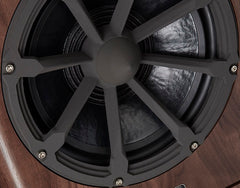
The very unusual looking 12" woofer features a dual basket that supports both ends of the magnet structure while providing a large heat sink that helps to prevent power compression. A rigid, 12" high-excursion cone is driven by magnetics that are designed to provide high linearity over a large excursion. The unusually low distortion produced by this driver keeps harmonics out of the midrange and upper bass. In the MB2S, the woofer is cut off above 380 Hz, using a 24 dB/octave Linkwitz-Riley crossover. This low cutoff frequency and steep slope confine the woofer to its most linear operating region. The loading provided by the ATL transmission line helps to keep the woofer from producing harmonic distortion.
Midrange
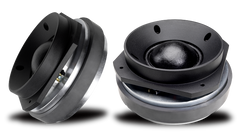
The midrange driver is hand assembled by PMC and weighs 22 pounds due to its very large coil and magnet structure. PMC claims it has the highest efficiency and lowest distortion of any 3" midrange driver. In the MB2S, this driver operates over a wide 380 Hz to 3.8 kHz range. This range encompasses most of the human vocal range and this means that vocals are reproduced by a single driver without any of the negative effects of crossovers. Likewise, many musical instruments occupy this important range of frequencies. When we consider how much of the audio spectrum is reproduced by this driver, we can begin to see why this driver has a 3" voice coil and weighs 22 pounds! Remember, the MB2S monitors are designed to deliver high sound pressure levels. These drivers are up to the task!
Tweeter
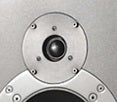
The 1" PMC/SEAS soft-dome tweeter uses a pre-coated Sonolex material. This driver operates above the 3.8 kHz crossover frequency. The 1" voice coil is ferrofluid cooled. Most importantly, this driver is closely spaced above the midrange driver. The midrange mounting flange is cut away to allow the closest possible spacing to the tweeter. This spacing is small enough to provide tight imaging at close distances.
Close Driver Spacing
The vertical alignment and close vertical spacing of the drivers help to provide tight integration between the drivers. When driven through the time-aligned passive crossover networks, the drivers create a tight, well-focused image of each musical voice. The large size of the cabinets imply that these speakers need to be placed at a distance, but the truth is that they behave just as well at mid-field to near-field distances. We used an 8 foot spacing and an 8 foot distance to each speaker, but found that the imaging held up well at closer distances. This ability to image at close distances is highly unusual for such large monitors.
Summary
While there has been a strong trend toward powered monitors, external amplifiers can offer significant advantages over the typical built-in class-D amplifiers. In side-by-side listening, powered monitors were no match for the noise-free, distortion-free output of this test system.
Using the voltage sensitivity of the passive monitors, and the voltage output of the amplifier, we can determine the peak SPL that the amplifier/monitor system can deliver. This task is simplified when the amplifier has regulated power supplies. An amplifier with tightly regulated power supplies can produce consistent and repeatable peak output voltages into a variety of impedances.
Noise emanating from the speakers (at a distance of 1 meter) can be calculated by subtracting the amplifier SNR from the calculated peak SPL. If more accuracy is required, the amplifier's output noise voltage in dB volts can be added to the speaker's voltage sensitivity.
When selecting an amplifier/speaker combination, think voltage, not power! When amplifier output and speaker sensitivity are expressed in terms of voltage, the calculations are easy.
Also in Audio Application Notes

How Loud is the Distortion from Your Power Amplifier?
by John Siau August 08, 2025
Would you put a Washing Machine in your Listening Room?
If the answer is no, you may be surprised to discover that the distortion produced by your power amplifier may be louder than the noise produced by a major appliance.
Don't believe me? Take a look at Stereophile's test reports:
We selected 7 power amplifiers from Stereophile's top list of recommended amplifiers.
We took Stereophile's "THD+N vs. Power" plots for each, and replotted the data in a format that shows the loudness of the THD+N at the listening position.
The results are shocking!
Amplifier THD+N is louder than expected!
The distortion from your amplifier may be louder than a washing machine on the spin cycle, or it may be totally silent. How does yours perform? The answer is hidden in Stereophile's THD+N plots.
This application note reveals the hidden truth:
"The Distortion from your Power Amplifier may be Louder than a Washing Machine!"
I know, it sounds crazy, but this is what the measurements show!

Interpolator Overload Distortion
by John Siau November 20, 2024
Most digital playback devices include digital interpolators. These interpolators increase the sample rate of the incoming audio to improve the performance of the playback system. Interpolators are essential in oversampled sigma-delta D/A converters, and in sample rate converters. In general, interpolators have vastly improved the performance of audio D/A converters by eliminating the need for analog brick wall filters. Nevertheless, digital interpolators have brick wall digital filters that can produce unique distortion signatures when they are overloaded.
10% Distortion
An interpolator that performs wonderfully when tested with standard test tones, may overload severely when playing the inter-sample musical peaks that are captured on a typical CD. In our tests, we observed THD+N levels exceeding 10% while interpolator overloads were occurring. The highest levels were produced by devices that included ASRC sample rate converters.

Audiophile Snake Oil
by John Siau April 05, 2024
The Audiophile Wild West
Audiophiles live in the wild west. $495 will buy an "audiophile fuse" to replace the $1 generic fuse that came in your audio amplifier. $10,000 will buy a set of "audiophile speaker cables" to replace the $20 wires you purchased at the local hardware store. We are told that these $10,000 cables can be improved if we add a set of $300 "cable elevators" to dampen vibrations. You didn't even know that you needed elevators! And let's not forget to budget at least $200 for each of the "isolation platforms" we will need under our electronic components. Furthermore, it seems that any so-called "audiophile power cord" that costs less than $100, does not belong in a high-end system. And, if cost is no object, there are premium versions of each that can be purchased by the most discerning customers. A top-of-the line power cord could run $5000. One magazine claims that "the majority of listeners were able to hear the difference between a $5 power cable and a $5,000 power cord". Can you hear the difference? If not, are you really an audiophile?


